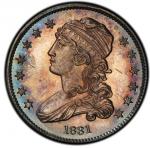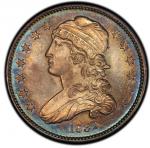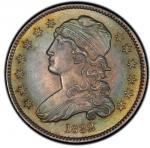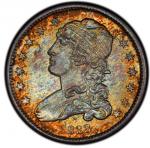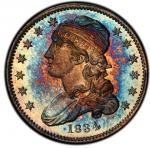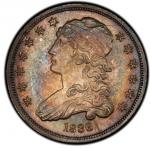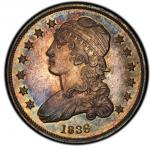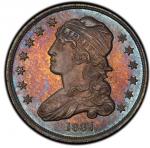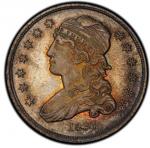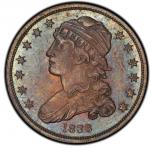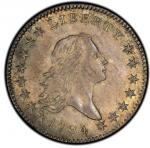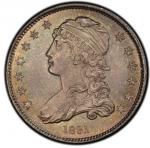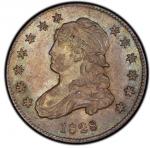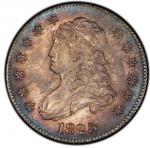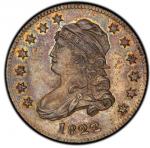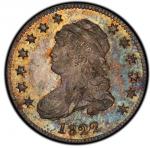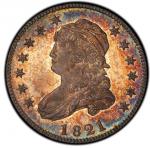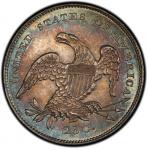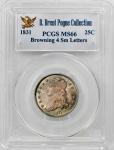I wanted this coin in the best possible condition, as it is rare. — Lelan RogersThe finest known 1797 half dollar, the finest example of a Small Eagle half dollar, and perhaps the most valuable half dollar in existence. Both sides are alive with color, the obverse radiant gold and violet framed in pale blue and champagne, the reverse lavender and blue suffused with pale gold. From arms length, this appears to be the most beautiful coin imaginable, lightly reflective but still showing full lustrous cartwheel. At noses tip, its value increases, as the full star centers of the left obverse emerge, the individual hairs can be counted, and the anatomical detail of the eagle becomes clear. The right obverse stars are somewhat flat, as seen on the MS-65+ (PCGS) Koshkarian coin, and an area below the shoulder curl is a bit bluntly defined. The eagle, always weak, is stronger than on any other known example, including the Koshkarian coin. The few marks include a couple of tiny contact points in the field between Libertys chin and chest and a small abrasion lower than the second A of AMERICA. The rarity of this date is perhaps related to the die cracks on both sides, with the obverse heavily cracked through star 2 to center. More delicate cracks range from the outer points of stars 2 through 5, across the latter star, into the field above the hair ribbon. Another seems to begin or end at nearly the same place, arcing above the ear, through Libertys face and nose, and down to the inner point of star 14. The reverse, still in use from 1796, shows even worse cracks. A heavy crack from the rim above D of UNITED to the wing is one side of a misshapen rhombus, bordered by a crack joining the bases of ST of STATES, another that runs through the upright of T to the eagles head, and another from the back of the eagles head through the wing to left. Further cracks descend through that wing at left to the leg, through N of UNITED to the foot, through the tops of TES to O of OF, and multiple cracks from the rim nearby that end up at the eagles beak, the wing at right, the foot at right, and beyond. This die could have broken after this strike; indeed, it is a wonder it could strike this example.Comparison of this coin and the 1796 that has been its long-term mate reveals similarities of toning and surface, fine patterns of texture and color that come from being in the same places for generations. Few pairs of American coins have remained together for so long outside of institutional collections. Since Virgil Brands acquisition of these two coins, between 1890 and 1920, they have only been apart for four years, the length of time the companion 1796 was in the John Whitney Walter Collection of coins of 1796. Since 1999, they have been united again in the D. Brent Pogue Collection.Though there have been five 1797 half dollars graded at various Mint State levels by PCGS, any conversation on this date centers on two examples: the Norweb-Koshkarian coin and this one. The Koshkarian coin has set a record for the most valuable half dollar ever sold twice, first when we sold it for $966,000 in our American Numismatic Rarities March 2004 sale, and again when we sold it (as Stacks) in July 2008 for $1.38 million, a record that still stands today. That gem example is graded MS-65+ by PCGS, but this one has been certified even finer. Most observers consider this coin the finest known by a slim margin; after these two, no other comes close.There are two specimens that are truly superb examples, David Hall has written about these two coins. In 1995, at its last auction appearance, this Pogue Collection example brought $517,000, almost $200,000 more than the 1796 that has been its near constant companion. Though most collectors acquire just one example of this Draped Bust, Small Eagle half dollar to represent this rarest design type among American silver coins, those who specialize in half dollars and seek to acquire both the 1796 and 1797 issues find the 1797 to be more elusive. As the single finest example of the more elusive date of the rarest of all silver design types in the entire American series (considering all grades combined), this coin may well become the most valuable half dollar ever sold.

